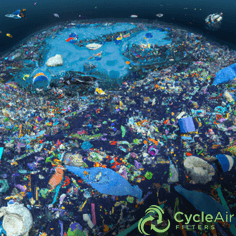
The Crisis In Our Ocean - The Great Pacific Garbage Patch
| Scott C
The Great Pacific Garbage Patch, also known as the Pacific Trash Vortex, is a massive area of the Pacific Ocean where marine debris, mostly plastic, has accumulated. It is estimated to be twice the size of the state of Texas and is a growing problem for marine life and the environment.
Here are a few ways households can help reduce their contribution to the Great Pacific Garbage Patch:
- Reduce single-use plastic consumption: This includes obvious items such as plastic bags, straws, and water bottles. It also includes some less obvious consumables like flossers, prepared food, or anything with excessive packaging.
- Properly dispose of trash and sort recycling: This includes properly disposing of waste that should go to landfill (and not dumped/littered), but its also critical to sort recycling according to your municipal guidelines.
- Use reusable items: Search for alternatives for anything designated as single use. Lunch containers, cloth diapers, and even reusable air filters for your HVAC, like Cycle Air's permanent, washable filters.
- Support plastic reduction and recycling efforts: This includes supporting industries and companies that are at the forefront of change with respect to manufacturing, sustainable business practices, and being environmental stewards.
Every household can vote with their wallet by purchasing sustainable items over convenience, but we'd be remiss to not acknowledge that much of the burden lies outside of the household. There are also many larger contributors to the Great Pacific Garbage Patch. These include:
- Industrial sources: Industries that produce and use large amounts of plastic, such as the fishing and shipping industries, can contribute to plastic pollution in the oceans.
- Improper waste management: Inadequate waste management infrastructure in some countries allows plastic waste to enter the ocean.
- Littering & Dumping: Public policy and cultural values can drive the right decisions for the environment.
To reduce these larger contributions, there are a few things that can be done:
- Implementing policies and regulations: Governments can implement policies and regulations to reduce plastic pollution from industrial sources and improve waste management.
- Increasing recycling and waste management infrastructure: Improving waste management infrastructure in countries with inadequate systems can help reduce the amount of plastic waste that ends up in the ocean.
- Educational campaigns: Increasing awareness about plastic pollution and encouraging people to properly dispose of waste can help to reduce litter.
There are a number of great campaigns and non-profits helping to reduce and clean up the existing garbage patch. Those efforts must be complimented with a concerted effort to reduce the waste that ends up in our oceans to tackle the problem and save our oceans.
Overall, the Great Pacific Garbage Patch is a growing problem that requires the efforts of individuals, industries, and governments to address. By reducing single-use plastic consumption, properly disposing of trash, and supporting plastic reduction and recycling efforts, households can play a significant role in reducing the size of the patch. At the same time, Implementing policies and regulations, Increasing recycling and waste management infrastructure, and educational campaigns can help to reduce larger contributions to the patch.

Leave a comment
Your email address will not be published.